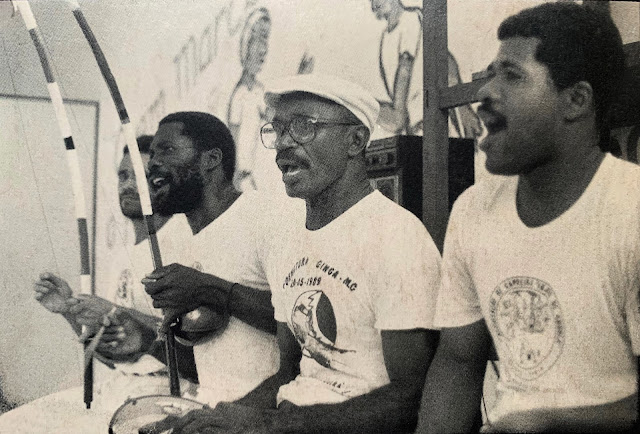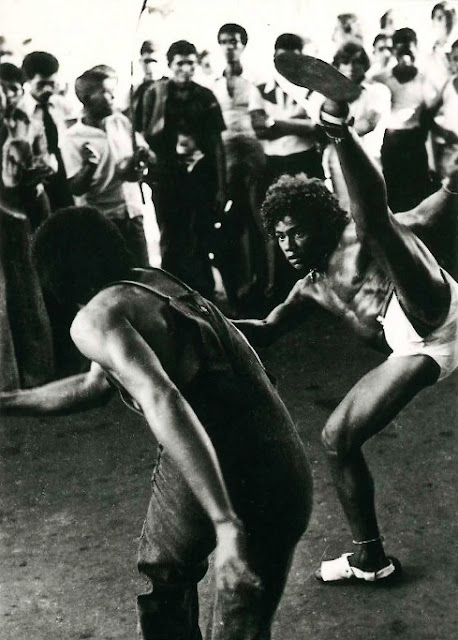BRAZIL – BRÉSIL
Mestre Paulo dos Anjos – Capoeira da Bahia – ABPC 470.048, released in 1991 (LP)
Last February, our friend João – a major contributor to this blog – traveled to Brazil for a month with stays in Salvadore de Bahia, a center for Capoeira, and Rio de Janeiro, where he attended two Capoeira rodas (circles) led by Mestre (master) Marrom. He also scouted out some vintage Capoeira LPs, including this gem, which he kindly shared with us.
The first written references to Capoeira, a martial art adopted by Afro-Brazilian slaves, date back to the 18th century. Because this practice was deemed subversive – as this system of master to disciple transmission was seen as empowering Afro-Brazilians – it was banned and ruthlessly repressed, first by the Portuguese colonial authorities, followed by the Brazilian government after the country’s independence in 1822. The ban persisted even after the abolition of slavery in Brazil in 1888. Abolition proved bittersweet for many free former slaves, who sometimes lost their homes and jobs and were left both abandoned and marginalized. In this context, some capoeiristas used their elite fighting skills in organized crime and committed acts of violence during this period, which further tarnished Capoeira’s reputation.
Because of these circumstances, from the very beginning Capoeira had to be practiced in secret, and practitioners who were caught by the authorities risked long prison sentences. Apart from the obvious general African cultural influences – the ritual, the rhythms and call-response, the sensuous dance-combat movements, etc. – very little is known about Capoeira’s precise origins. All the less so, since from its very origins, and by design, groups of African-born slaves in Brazil included a mix of people from a wide variety of ethnic/cultural groups, including Yoruba, Ashanti, and people from Gabon, Congo, Angola and Mozambique.
When Capoeira was ultimately legalized and decriminalized in 1940, it rapidly flourished, particularly in large urban centers like Salvador de Bahia, Rio de Janeiro and Recife, under the impetus of two new Capoeira schools. The first, Capoeira Regional, founded in1932 by Mestre Bimba (1899-1974), modernized Capoeira via its methodical training of the martial art, faster movements and leaving behind certain traditional elements considered superfluous. A second, more traditional school, founded in Salvadore de Bahia in 1941 by Mestre Pastinha (1889-1981) was called Capoeira Angola. This school adopted slower movements and emphasized its African roots.
João also mentioned the importance of the extended community around Capoeira academies and the Mestre, in a joyful, leisurely and benevolent collective spirit, suffused with “an African grace.” To keep the collective spirit from being disrupted by competitiveness, Capoeira Angola academies don’t use a ranking system for capoeiristas, as they do in Capoeira Regional. Capoeira also has a strong racial, social and political conscience, and promotes inclusiveness and gender parity – women capoeiristas participate in rodas and can become Mestres.
In Capoeira music the fascinating berimbau – a single-string percussion descending from African musical bows – takes center stage. Typical Capoeira Angola ensembles include three berimbaus of different pitches and sizes, including the longest bass-sounding berimbau berra boi, most often played by the Mestre, two other shorter, higher-pitched berimbaus, an atabaque hand drum, two pandeiro tambourines, a reco-reco scrubbing percussion and agogo bells.
This exquisite spellbinding Capoeira Angola album by Mestre Paulo dos Anjos (1936-1999) from Salvador de Bahia features his gorgeous commanding and inspired mellifluous voice, sung responses from the capoeiristas and precise, fluid rhythms.
En février dernier, notre ami João s'est rendu au Brésil pendant un mois avec des séjours à Salvadore de Bahia, un centre majeur de la Capoeira, et à Rio de Janeiro, où il a assisté à deux rodas (cercles) de Capoeira dirigés par Mestre (maître) Marrom. Il a également déniché des vieux disques de Capoeira, dont ce bijou, qu'il partage avec nous.
Les premières références écrites mentionant la Capoeira, un art martial adopté par les esclaves afro-brésiliens, remontent au XVIIIe siècle. Cette pratique jugée subversive, un système de transmission de maître à disciple exprimant une affirmation de pouvoir des Afro-Brésiliens, fut interdite et durement réprimée, d'abord par les autorités coloniales portugaises, puis par le gouvernement brésilien après l'indépendance du pays en 1822. Cette interdiction persista même après l'abolition de l'esclavage au Brésil en 1888.
En raison de ces circonstances, la Capoeira a dû, dès ses débuts, être pratiquée dans la clandestinité et le plus grand secret car les adeptes arrêtés par les autorités risquaient de lourdes peines de prison et de nombreux coups de fouet. En dehors des influences culturelles africaines générales évidentes – le rituel, les rythmes et les appels-réponses, les mouvements sensuels de danse-combat, etc. – très peu de choses sur les origines précises de la Capoeira sont connues. D'autant moins que dès le départ, les groupes d'esclaves au Brésil nés en Afrique comprenaient, à dessein, un mélange de personnes issues de groupes ethniques/culturels très différents, notamment les Yoruba, les Ashanti et des peuples du Gabon, du Congo, d’Angola et du Mozambique.
Lorsque la Capoeira fut légalisée et décriminalisée en 1940, elle connait un essor rapide, tout particulièrement dans les grands centres urbains comme Salvador de Bahia, Rio de Janeiro et Recife, sous l'impulsion de deux nouvelles écoles de Capoeira. La première, la Capoeira Regional, fondée en 1932 par Mestre Bimba (1899-1974), modernisa la Capoeira à travers un apprentissage méthodique de l'art martial, l’adoption de mouvements plus rapides et l'abandon de certains éléments traditionnels jugés superflus. Une deuxième école, plus traditionnelle, la Capoeira Angola, fut fondée à Salvadore de Bahia en 1941 par Mestre Pastinha (1889-1981). Cette école conserva les mouvements lents de la Capoeira d’antan et afficha ses racines africaines.
João souligne également l'importance de la communauté élargie autour des académies de Capoeira et du Mestre, dans un esprit collectif empreint de joie, de bienveillance, de sérénité et d'une "grâce africaine". Afin d’éviter que l'esprit collectif ne soit perturbé par la compétitivité, les académies de Capoeira Angola n'utilisent pas de système de classement pour les capoeiristas, comme le font les académies de Capoeira Regional. Les académies de Capoeira ont également une forte conscience raciale, sociale et politique, et promeuvent l'inclusion et la parité des sexes – les femmes capoeiristes participent aux rodas et peuvent devenir des Mestres.
Dans la musique Capoeira, le fascinant berimbau – une percussion monocorde descendant des arcs musicaux africains – occupe une place centrale. Les ensembles de Capoeira Angola comprennent trois berimbaus de hauteurs et de tailles différentes, dont le long berimbau berra boi basse, le plus souvent joué par le Mestre, deux autres berimbaus plus courts et plus aigus, un tambour à main atabaque, deux tambourins pandeiro, une percussion reco-reco raclée et une cloche agogo.
Cet album envoûtant de Capoeira Angola de Mestre Paulo dos Anjos (1936-1999) de Salvador de Bahia présente sa magnifique voix mélodieuse empreint d’autorité et d’inspiration, les réponses chantées des capoeiristes et des rythmes fluides et précis.
A3 Não Sei o Que Fazer/I Don’t Know What To Do
I don’t know what to do,
To live in this world,
If you have a tidy appearance you're lazy,
If you have an untidy appearance you're filthy;
Troubled world,
Above all deceptive,
If you eat little you're stingy,
If you eat a lot you are greedy,
If you speak you're a loudmouth,
– dear God,
If you don’t you're suspicious;
I grew up in the world,
The world that taught me,
When you're beaten up, you're a coward,
When you kill, you're an assassin,
Dear comrad (Camaradinha);
It's time it's time;
Yeh! It's time it's time, comrad,
Yeh! the rooster has crowed,
Yeh! the rooster has crowed;
Yeh! Cocorôcô,
Yeh! cocorôcôcô, comrad;
Yeh! Long live my Master,
Yeh! Long live my Master, comrad.
Yeh! Who taught me,
Yeh! Who taught me, comrad;
Yeh! Around the world,
Yeh! Around the world, comrad.
A4 Ele Diz que Eu Sou Covarde / He Says I'm a Coward
Yeh!
He says I'm a coward,
He even says I'm afraid.
My mother warned me,
When you play Capoeira,
You better watch out while it's still early,
A one-eyed chicken,
Returns to the coop early.
I responded to my mother:
A thin water drip,
Will never break a rock,
Comrad.
A4 Meu Senhor Mandou Chamar / My lord Sent for Me
O yayá, my lord [slave master] sent for me,
My lord sent for me, o yayá,
From the Mercado Popular [port area in Salvador da Bahia were Afro-Brazilian capoeiristas looked for work and performed in public], o yayá.
I'm playing Capoeira now, o yayá,
I'm only going when it's over, o yayá.
Pull, pull, push, push, throw it this way, o yayá,
But those who can't summon, better not do it, o yayá,
Leave it for those who can, o yayá.
I tied a knot, I kept the end of it,
You will not untie it, o yayá.
If Marcelino is to die, o yayá,
Let Marça's wife die instead, o yayá,
Rather than letting good people die, let bad ones die instead.
But my lord sent for me, oh, yayá,
From the Mercado Popular, oh yayá,
I'm playing Capoeira, tell him I'm coming soon, oh yayá,
I'm playing Capoeira, oh yayá,
At the Mercado Popular, o yayá.
B1 – Declamação do Mestre Paulo dos Anjos
Hey people, my name is Paulo Dos Anjos,
Look guys, my life is an open book, my name is Paulo dos Anjos, born in Sergipe, raised in Bahia, a fatherless son raised by a poor mother, withstanding much suffering.
I started to learn Capoeira in the 50s, with Mestre Canjiquinha, although the first capoeirista I met was Mestre Bimba, when I was a child, in Barano(?), and now I have an academy there at kilometer 17 (Salvador de Bahia), in the Itapuã neighborhood; I also have another academy in São Paulo.
I have good students, I live a good life and continue to embrace the life I love, the Capoeira life, all about beauty. I get help from my friends, because I have many friends throughout Brazil.
I advise you to take everything I do as an example, not to create problems, not to be problematic because Capoeira is not what people say it is, ok beleza(?),
Many doctors play Capoeira, many more doctors play Capoeira than football, we must therefore play Capoeira.
B2 - O Discípulo e a Arte / The Disciple and the Art
About this art I have some knowledge,
The master taught me,
I then passed it down to someone else;
I trained good teachers,
All are all well educated,
And I will prove it to you sir;
I'm proud of this art,
It was God who helped me;
He is Mandingueiro,
Yeh! He knows how to play,
Yeh! throw yourself here,
Yeh! throw yourself there [combat-dance].
Capoeira - Documentos Folcloricos Brasileiros - Editota XAUA, EX-1.002, 1960 here
%20-4%2080.jpg)
%20-5%2074.jpg)




Thanks so much for the wonderful music!
ReplyDeleteJust to kindly inform you that the download links now function properly.
ReplyDeleteThanks for sharing. Great!
ReplyDeleteA very lovely share to which I'm listening right now. Sound quality is amazing.
ReplyDeletePS I should have said: >>another<< lovely share. Thanks so much for your dedication.
ReplyDeleteThe outstanding music, comprehensive texts, lyrics and gorgeous visuals all show your great respect for our species’ incredibly rich heritage. Your blog is a unique living treasure. Please never stop!
ReplyDeleteThank you for intriguing insight & João for providing this treasure!
ReplyDeleteThank you for share!
ReplyDelete